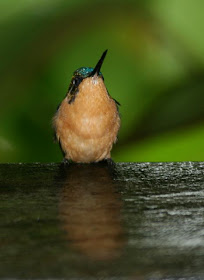 Gardens at Los Quetzales in Guadalupe, Panama.
Gardens at Los Quetzales in Guadalupe, Panama.
After an early morning flight to the David airport in the western highlands of Panama, our group had breakfast at
Los Quetzales lodge and spa in Guadalupe. This hotel, well-known to tropical birding tour companies, is located in a small village near the cloud forest of Volcan Baru National Park. It being the "green" (or rainy) season in Panama, it felt like we were already IN the cloud forest. The temperature at this altitude (about 7,000 feet above sea level) was much cooler than in Panama City and a misty rain was falling.
 Around the table at Los Quetzales.
Around the table at Los Quetzales.
Carlos, the owner of Los Quetzales, was a delightful host during our stay. His hotel, as its name suggest, is decorated with a quetzal/cloud forest theme, which only made me MORE anxious about seeing a resplendent quetzal.
 Cloud forest in Volcan Baru National Park in the province of Chiriqui in Panama.
Cloud forest in Volcan Baru National Park in the province of Chiriqui in Panama.At Los Quetzales, while waiting to leave for our first field trip, some of us had slaty flower piercers and green violet-eared hummingbirds in the gardens. Rufous-collared sparrows hung around like house sparrows, as common as dirt.
Soon we took a bus to a nearby road into the park and began birding in earnest. The day remained mostly gray and rain came in fits and starts—not enough to disrupt our birding, but enough to have to wipe our binoc lenses dry every few minutes. I was glad I'd brought my Muck Boots, even though they'd garnered me some ridicule from my fellow travelers. Was it the fact that I wore them on the plane ride to David? Or was it the boots' distinctive hunter-orange linings?
 My ossumly orange muck boots in the David Airport. Sneaky photo by Jeffrey A. Gordon.
My ossumly orange muck boots in the David Airport. Sneaky photo by Jeffrey A. Gordon.Anyway, back to the rainy cloud forest. . . which is redundant, I realize.
The birds did not seem to mind the temperature or the rain. Among the first species we all got good looks at were mountain thrush, black-billed nightingale-thrush, and ruddy treerunner (which looked like a 'roided-up brown creeper).
 The group on the cloud forest trail. Far right is our guide, Ito, from Los Quetzales.
The group on the cloud forest trail. Far right is our guide, Ito, from Los Quetzales.
We had a smattering of "our" birds, too, including Wilson's and a black-and-white warblers.
I tried taking a few photos, but the rain was a bit daunting and the light was dim. We all donned our raincoats, ponchos, and hats. Some of us improvised, creating umbrellas from whatever was at hand.
 Mike Frieberg with his jungle umbrella.
Mike Frieberg with his jungle umbrella.
 Lisa White sheltering from the storm.
Lisa White sheltering from the storm. Jeffrey A. Gordon trying to keep camera and head dry.
Jeffrey A. Gordon trying to keep camera and head dry.The road we were walking on seemed suitable only for foot or perhaps donkey traffic. We were shocked, however, to hear the rumble of an engine coming down the mountain. A few minutes later, a rickety farm truck pulled around the bend, belching exhaust, with a load of home-grown lettuce for the local market. Much of Panama's agriculture happens in this part of the country, blessed as it is with rich volcanic soil and ample water.
 The Lechuga Express passing Jeff Gordon. Only really good drivers pass Jeff Gordon.
The Lechuga Express passing Jeff Gordon. Only really good drivers pass Jeff Gordon.
After about an hour on the trail, and while we were sorting through a small feeding flock of tanagers, thrushes, and warblers, I saw a large greenish bird swoop into a tree far above me. Its red belly meant it could only be one thing: a female resplendent quetzal! The looks were not great, but we all got to see her and one or two other younger birds. This would prove to be our only looks at this spectacular species. It was nice, but, who wouldn't want more?
Still, Los Quetzales had lived up to its name.
The rain started coming down harder. We tried another spot or two, then decided that we'd go back to the hotel to wait for the weather to break a bit.
 Liam at the school party as Batman in his store-boughten costume. For more on the costume decisions, see Zick's blog.
Liam at the school party as Batman in his store-boughten costume. For more on the costume decisions, see Zick's blog.











































